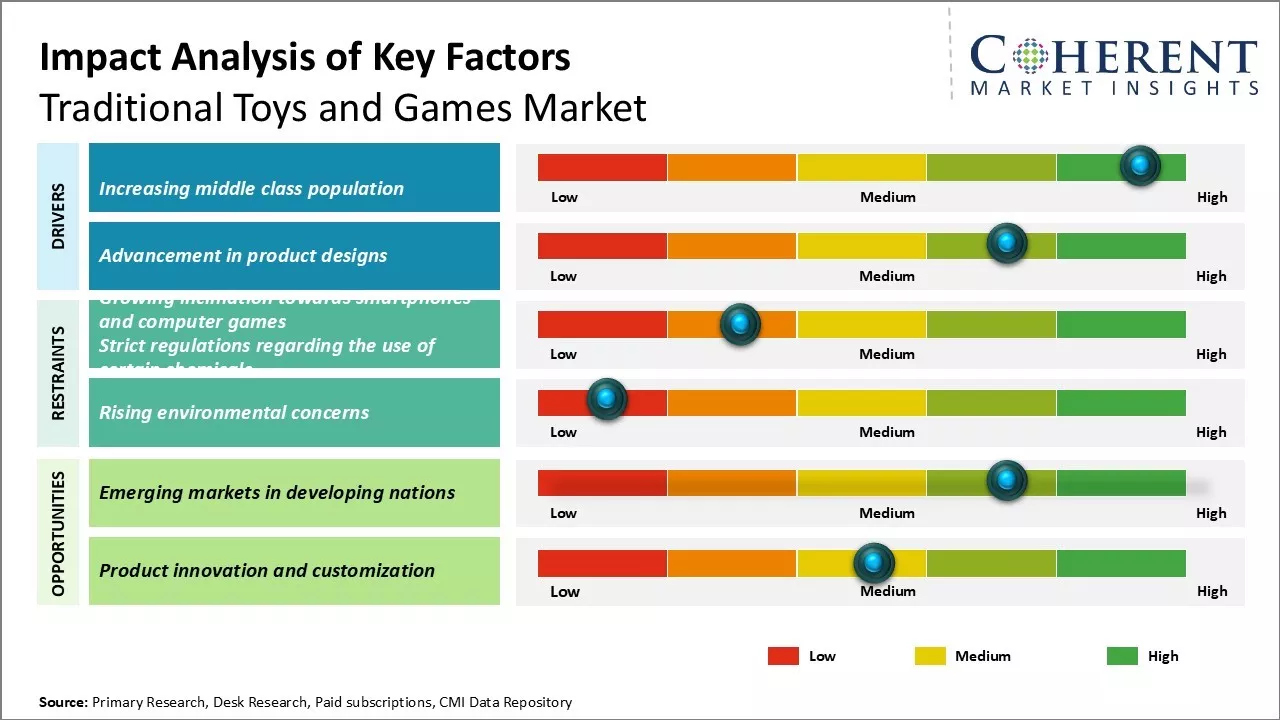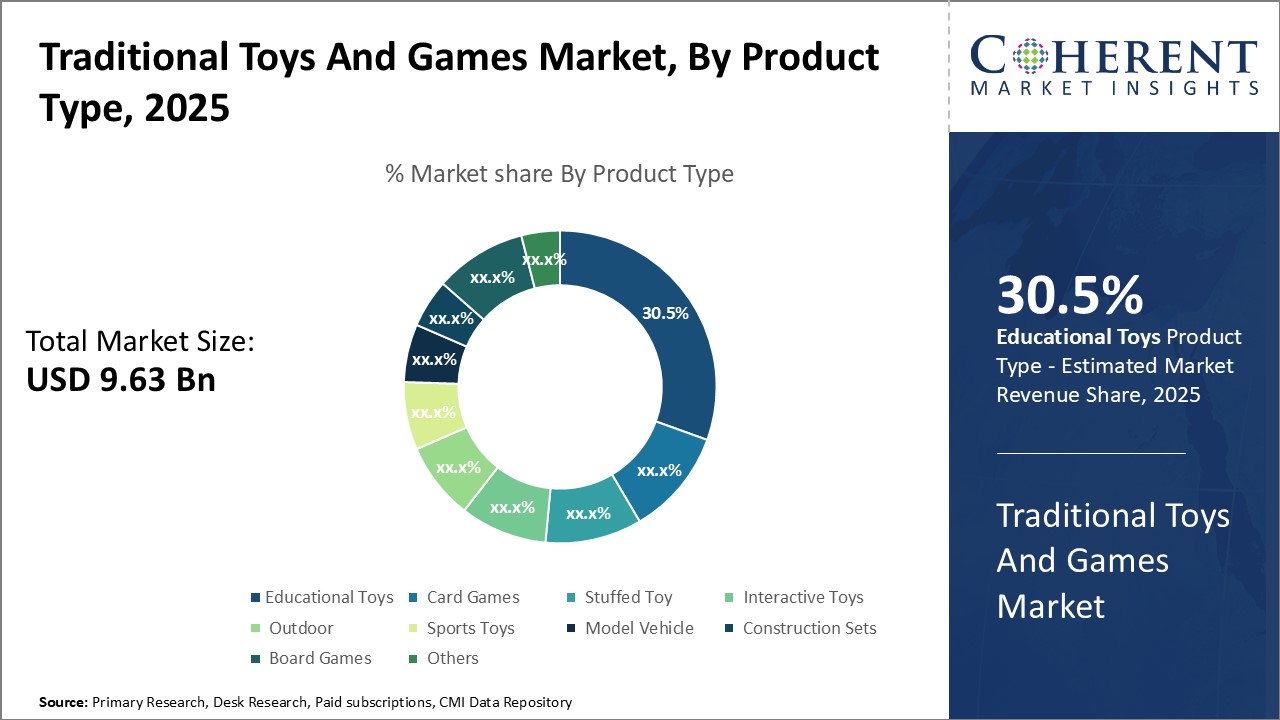The traditional toys and games market is estimated to be valued at USD 9.63 Bn in 2025 and is expected to reach USD 12.17 Bn by 2032, exhibiting a compound annual growth rate (CAGR) of 3.4% from 2025 to 2032.

Discover market dynamics shaping the industry: Download Free Sample
The traditional toys and games market has been witnessing consistent growth driven by the growing popularity of several board games, construction toys, arts and crafts, and outdoor and sporting toys among both children and adults. However, increased digitalization and preference for electronic devices among kids pose challenges for the market. Nevertheless, key players such as Agro A/S are focusing on integrating traditional toys with latest technologies to provide interactive and engaging gameplay, thereby appealing to changing consumer patterns.

Discover high revenue pocket segments and roadmap to it: Download Free Sample
Insights, By Product Type - Educational value drives demand for educational toys
Educational toys segment is estimated to contribute the highest market share of 30.5% in 2025 of the traditional toys and games market, owing to the growing focus on early childhood education. Parents and caregivers recognize the developmental benefits that educational play provides for young minds. Toys that stimulate creativity, problem solving, dexterity, and other skills help promote school readiness from a young age.
This segment continues expanding due to broader acceptance that learning should be playful and fun. Educational toys engage children in hands-on exploration of subjects like science, technology, engineering, and mathematics (STEM). Many features buildable components, basic coding functions or interactive lessons on numbers, letters, animals, and more. By sparking curiosity in educational concepts through amusement, these toys keep children engaged with learning outside of school hours.
Insights, By Distribution Channel - The online segment is a key driver of growth in distribution channels
The online segment is estimated to hold 55.7% share within the traditional toys and games market in 2025. The convenience of online shopping continues attracting more parents to buy toys over the internet rather than in person.
Websites and apps allow buyers to conveniently browse extensive product selections from the comfort of their homes at any time. Detailed reviews and ratings from other customers help evaluate options more easily online compared to physical stores with limited shelf space. This makes research and decision making simpler for time-pressed families.

Need a Different Region or Segment? Download Free Sample
Regional Analysis: Traditional Toys and Games Market
Dominating Region: North America
North America is expected to account for the greatest revenue share of 35.8% in 2025. North America’s dominance in the traditional toys and games market can be attributed to the strong presence of major manufacturers such as Hasbro and Mattel. With their innovative products and diverse portfolio, these companies have developed a loyal customer base in the region over the years.
Fastest-Growing Region: Asia Pacific
The Asia Pacific region exhibits the fastest growth riding on the trends of increasing urbanization, exposure to western pop culture, and rising middle class spending power especially in emerging countries such as India and China. The governments' support for local toy industries has also provided a fillip.
Traditional Toys and Games Market Outlook for Key Countries
U.S.: The U.S. market continues to be driven by the demand for classic board games and construction toys among families.
China: The China market is witnessing diversification as local players offer innovative translations of western products as well as develop toys based on domestic television animations.
India: Led by MamaMia and Channapatna Toys, the India market continues to lead in traditional hand-crafted toy production while global brands are tapping opportunities through partnerships.
Japan: Despite advances in digital technology, traditional Japanese toys such as paper crafts and puzzles retain popularity given their emphasis on problem-solving skills.

Get actionable strategies to beat competition: Download Free Sample
Top Strategies Followed by Traditional Toys and Games Market Players
Emerging Startups in the Traditional Toys and Games Market
Innovative Technologies: Several startups are developing advanced technologies like AI, AR, and 3D printing to transform the toy-making process. Anthropic focuses on AI safety to build toys that are beneficial for children's development. They are working on educational AI toys that improve learning outcomes. Anthropic aims to make AI ubiquitous in kids' playtime while ensuring it always has their best interests in mind. Additionally, companies like Replicade are 3D printing customized mini-figures based on photos to create truly unique toys.
Sustainable Solutions: Some startups are innovating with sustainability in mind. For example, Seedling creates toys, books, and games using recycled paper, wood, and natural materials. All their products are non-toxic, Forest Stewardship Council (FSC-certified, and plastic-free.) Their goal is to offer sustainable toy alternatives that are just as engaging and educational. With increased environmental awareness, such startups are driving the shift towards eco-friendly toys made using renewable, biodegradable resources.
Key Takeaways from Analyst
Traditional Toys and Games Market Report Coverage
| Report Coverage | Details | ||
|---|---|---|---|
| Base Year: | 2024 | Market Size in 2025: | USD 9.63 Bn |
| Historical Data for: | 2020 To 2024 | Forecast Period: | 2025 To 2032 |
| Forecast Period 2025 to 2032 CAGR: | 3.4% | 2032 Value Projection: | USD 12.17 Bn |
| Geographies covered: |
|
||
| Segments covered: |
|
||
| Companies covered: |
Dream International Limited, Hasbro, Inc., Mattel, Inc., Funskool Limited, Lego A/S, Jakks Pacific Inc, Tomy Co. Ltd., LeapFrog Enterprises Inc., Spin Master Corp, Bandai Namco Holdings Inc, Playmates Toys Limited, Kids Ii Inc., Mega Brands Inc., Melissa & Doug Inc., Funko LLC, K'NEX Brands, L.P., Ravensburger AG, and Games Workshop Group PLC |
||
| Growth Drivers: |
|
||
| Restraints & Challenges: |
|
||
Uncover macros and micros vetted on 75+ parameters: Get instant access to report
Market Driver - Increasing middle class population
As the economies of developing nations continue their steady growth over the past few decades, more families have seen their livelihoods and incomes rise into the middle-class standings. This expanding segment of the population now has greater discretionary spending power and looks to provide enriching activities for their children. Traditional toys that foster creative and social development remain popular options.
Board games, construction toys, arts, and craft sets provide affordable forms of play that parents recognize can help build important life skills. As families have more money to spend on leisure and development, toys seen as educational supplements are gaining in the retail marketplace. According to data published by UNICEF in June 2023, the percentage of children enjoying organized sports and community play has significantly risen in middle-income households in Brazil, China, and South Africa between 2020 and 2022. This indicates parents are willing to spend on gear and facilities for fitness and social skills.
Market Challenge - Growing inclination towards smartphones and computer games
One of the major challenges facing by this market is the growing inclination of kids and families towards smartphones, tablets, and computer games. With advancements in technology, more immersive and interactive digital games are being developed which is attracting the younger audience away from traditional toys. Many kids now prefer to spend their leisure time playing games on mobile and computers instead of using physical toys. This has reduced the demand and sale of conventional toys. As reported in a November 2022 UNICEF study, children in developed nations spent an average of 7-8 hours daily on digital devices even before the COVID-19 pandemic accelerated online education and socialization. This underscores the immense popularity of digital entertainment over physical play, adversely hitting the sales of conventional toys.
Market Opportunity - Emerging markets in developing nations
The traditional toys and games market has a huge opportunity in the emerging markets of developing nations. With rising incomes and growing middle class population, the demand for toys is increasing rapidly in countries like India, China, Indonesia, Brazil, and others. As people in developing countries are becoming more affluent, they are willing to spend more on children's toys and leisure products. For instance, toys based on Superhero franchises from Marvel and DC have found huge fan following in countries like India, the Philippines, and Nigeria among young boys. According to UNICEF, in the Philippines alone, sales of action figures doubled from 2020 to 2022 among kids aged 5-12 years. The trend shows how western pop culture is influencing toy choices. International toy companies should look to tap into these emerging markets and introduce affordable toys catering to local tastes and preferences. Setting up manufacturing units in these regions can also help lower costs.
Share
Share
Missing comfort of reading report in your local language? Find your preferred language :
Transform your Strategy with Exclusive Trending Reports :
Frequently Asked Questions
Joining thousands of companies around the world committed to making the Excellent Business Solutions.
View All Our Clients